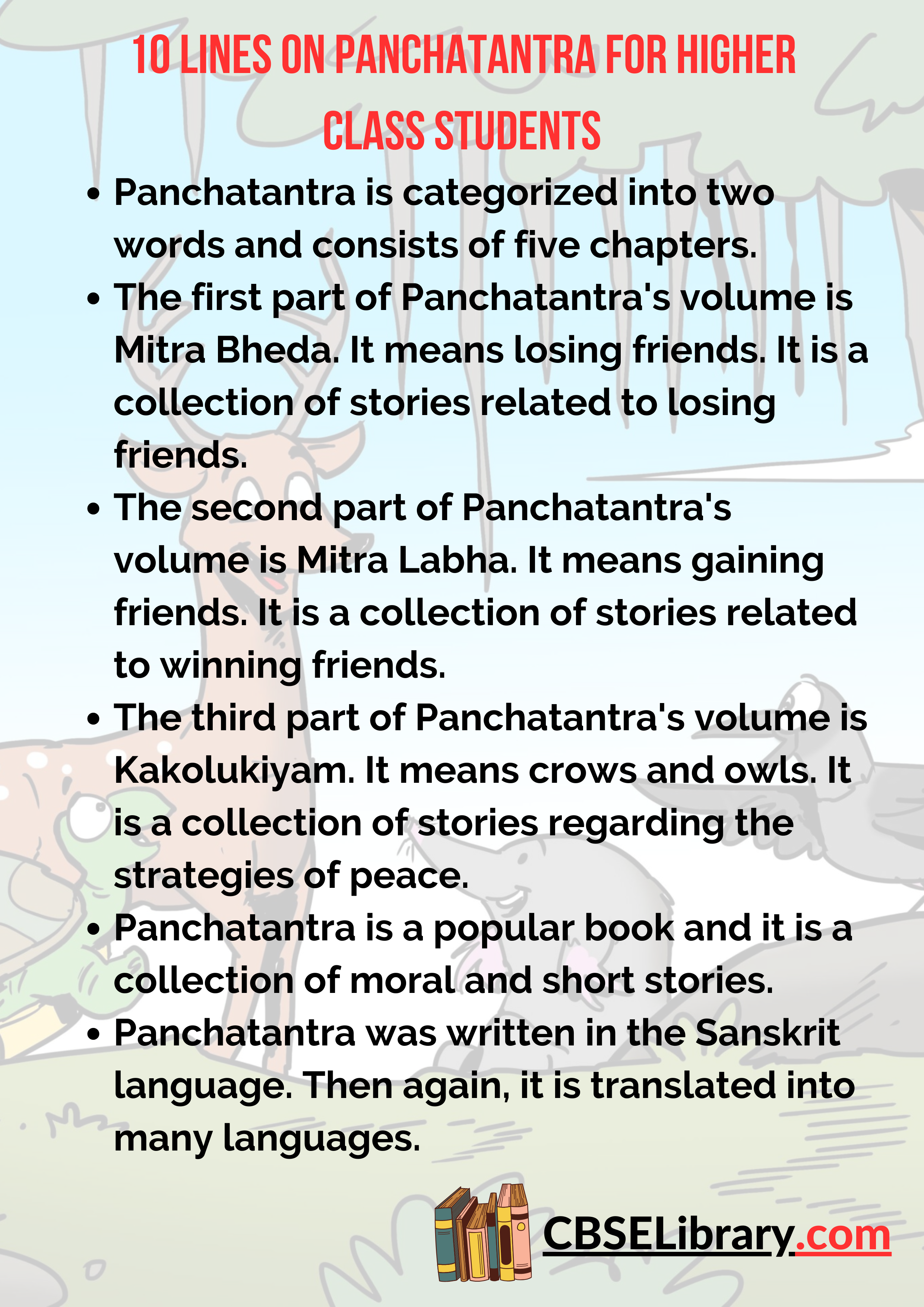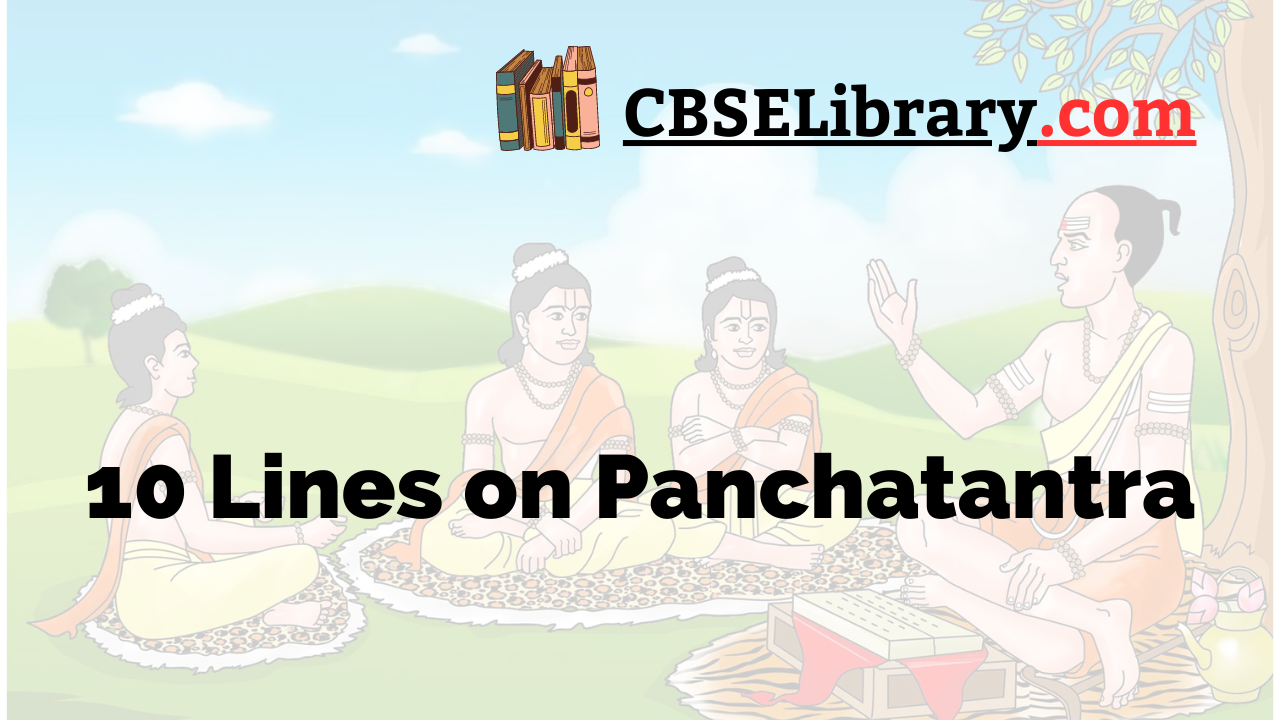10 Lines on Panchatantra: Panchatantra is one of the best books has that a collection of novel stories. The Panchatantra moral and short stories are one of the most popular collections of animal-based parables. Panchatantra was written in the Sanskrit language. Each of the stories has a moral in it. Panchatantra stories are appropriate and offer some valuable lessons in life.
Panchatantra is the best way to implant some moral values in life. Also, it is one of the best tricks for children to teach some values. Panchatantra is very easy to understand. It is literature where animals can talk with human beings. Now, check out the sets of 10 lines on Panchatantra.
You can read more 10 Lines about articles, events, people, sports, technology many more.
Set 1 – 10 Lines on Panchatantra for Kids
Set 1 is helpful for students of Classes 1, 2, 3, 4 and 5.
- The Panchatantra is written in the Sanskrit language, and written by Vishnu Sharma.
- Panchatantra is book since ancient times. It is an Indian collection of moral stories.
- Animals are the main characters of Panchatantra and leave a moral every time.
- Panchatantra came from two words. They are- Pancha (Five) and Tantra (Chapters).
- It is believed that Panchatantra was written in the second century.
- Panchatantra is the most significant book where humans can talk to animals.
- Panchatantra was composed to teach general conduct to the three sons of King Amarashakti.
- The main aim of composing Panchatantra was to offer some skills to the king’s sons
- Each of the stories of Panchatantra has the main moral story in which many stories are told in it.
- The stories of Panchatantra are divided into five parts. They are:
- Mitra Labha (Gaining Friends)
- Mitra Bheda (Losing Friends)
- Labdhapranasam (Loss of Gains)
- Apariksitakarakam (Acting Without Thinking)
- Kakolukiyam (Crows and Owls)

Set 2 – 10 Lines on Panchatantra for School Students
Set 2 is helpful for students of Classes 6, 7 and 8.
- The Panchatantra was translated into many languages that include Persian, Telugu, Hindi, Arabic, English and many more.
- Panchatantra is one of the most famous books that is the collection of moral stories.
- Panchatantra is the best source of the world’s parable literature.
- The stories of Panchatantra are easy to understand for anyone. It leaves a moral message to remember in their life.
- Panchatantra was composed by Vishnu Sharma and was written in Sanskrit.
- The main purpose of writing Panchatantra was to instil some morals in life.
- Panchatantra was originated in the kingdom of King Amarshakti. He appointed Vishnu Sharma to teach his three sons.
- In Europe, the work was known under the name of The Fables of Bidpai.
- In India, the Panchatantra is known as ‘Nitisastra’. It means ‘the wise conduct of life’,.
- The stories in Panchatantra teaches practical intelligence. Also, it promotes morals and values in life.
Set 3 – 10 Lines on Panchatantra for Higher Class Students
Set 3 is helpful for students of Classes 9, 10, 11, 12 and Competitive Exams.
- Panchatantra is a popular book and it is a collection of moral and short stories.
- Panchatantra was written in the Sanskrit language. Then again, it is translated into many languages.
- The stories of Panchatantra are easy to understand and they are very simple.
- Vishnu Sharma composed this Panchatantra book. The main purpose of Panchatantra is to offer some skills towards life.
- Panchatantra is categorized into two words and consists of five chapters.
- The first part of Panchatantra’s volume is Mitra Bheda. It means losing friends. It is a collection of stories related to losing friends.
- The second part of Panchatantra’s volume is Mitra Labha. It means gaining friends. It is a collection of stories related to winning friends.
- The third part of Panchatantra’s volume is Kakolukiyam. It means crows and owls. It is a collection of stories regarding the strategies of peace.
- The fourth part of Panchatantra’s volume is Labdhapranasam. It means loss of gains. It is a collection of stories that shows how to overcome challenges and difficulties in life.
- The fifth part of Apariksitakarakam. It means acting without thinking. It is a collection of stories that shows how non-thinking actions lead to losing what is essential.

FAQ’s on 10 Lines on Panchatantra
Question 1.
When was this Panchatantra written?
Answer:
It is believed that Panchatantra was written in the second century BC. It was originated in the kingdom of the King Amarashakti. Panchatantra was written by Vishnu Sharma
Question 2.
What is the importance of Panchatantra?
Answer:
Panchatantra is a collection of stories that leave us a moral in every story. It teaches some valuable life lessons. Also, it teaches teamwork, decision making, friendships, and alliances.
Question 3.
What are the five chapters of Panchatantra?
Answer:
Panchatantra has categorized into five parts. They are:
- Mitra Bhedha (Losing Friends)
- Mitra Labha (Gaining Friends)
- Labdhapranasam (Loss of Gains)
- Apariksitakarakam (Acting Without Thinking)
- Kakolukiyam (Crows and Owls)
Question 4.
How many stories are there in Panchatantra?
Answer:
All the stories in Panchatantra contain the wisdom of ages. Almost 85 stories are there in Panchatantra. It was originally written in the Sanskrit language. Panchatantra is a collection of short stories and constituted five volumes.
Question 5.
What is the derivation of Panchatantra?
Answer:
Panchatantra also called as Pancatantra. It has a collection of short and moral stories. Panchatantra came from two words. They are- Pancha (Five) and Tantra (Volumes).
